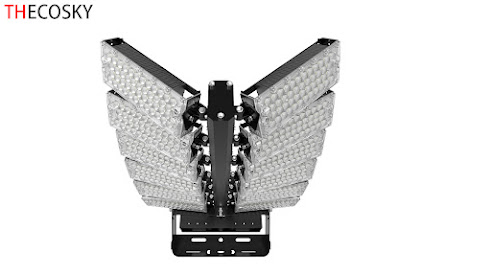The Guide to Sports Lighting - LED Stadium Lights
Why should I choose LED Lights rather than Halogen lamps?
In order to understand how light is generated, it is important to understand two independent processes. The first occurs before electricity reaches the LED light bulb and can be considered as a Power Consumption Process. The second takes place a little later, with the projection of light.
a. Power Consumption Process
By power consumption we refer to the percentage of energy that is not wasted and that is essential to turn on the light. In the ordinary halogen lights, up to 80% of energy is wasted during the power process. With our LEDs, the wasted energy is less than 10% so our sports LED lighting will require much less electrical energy and will reach and exceed the projection of light provided by halogen luminaires for stadium lighting.
b. Light Projection Process
The lighting process is the second phase. Once the luminary has been turned on, you need to project the light to the ground with great light intensity. This is where it is very important to distinguish between luminosity and efficiency.
HALOGEN STADIUM LIGHTS | LED STADIUM LIGHTS |
1: Lower Track Light Scope: Much lower efficiency. | 1: Higher Track Scope: Thanks to our unique optics, we are able to provide more light on the playing court than traditional lights or other LED manufacturers. |
2: Higher Power Consumption: Only 20-60% of the electrical energy is used to turn on the lights. A lot of power is wasted during the process. | 2: Lower Power Consumption: About 95% of the electricity is used to turn on the light, losing less than 5%. |
3: Low Efficiency: Only 60-80% of the voltage is correctly counterbalanced by the ballast. This means that the Power Factor is only 60-80% which causes significant interference on the electric current. If we assume that an installation includes other electrical equipment apart from luminaires, they will be affected much more negatively than if we use LEDs. | 3: High Efficiency Ballasts: LEDs use switched sources, exceeding 95% efficiency. They incorporate a capacitor that redistributes and compensates the voltage better. This means that there is better stability and less interference in the electrical circuit. |
4: Fragile: with high maintenance rate since they use glass tubes. | 4: Luminaires Resistencies: Manufactured shockproof |
5: High Reaction Time: Lights need at least 1 minute to reach their maximum brightness. | 5: Awesome Reaction Time: In milliseconds the LED Light turns on completely. |
6: Health Threat: A higher proportion of ultraviolet light is used. | 6: Ecological and Clean light source: LEDs focus on the visible color spectrum, so UV rays are hardly used. |
7: High Temperature: what makes the proportion of lost light greater. | 7: Cooler Light Source: Generates less heat as compare to ordinary bulbs. |
Why are LED Lights the key to perfect lighting in a stadium?
To choose the type of sports lighting to be installed in a field, it is not necessary to focus only on a solution that solves short-term problems of the installed luminaires. It should aim to improve the future quality of the playing field for the games being played as well as ensuring that maintenance costs are always within a budget.
LED stadium lights have significant advantages over metal halide sports lighters,
Both objectives can be achieved with the LEDLightExpert LED Luminaires. Therefore, choosing the right LED sports lights for your stadium is of super importance for a thriving business plan.
Is a high-power LED light more efficient just because it is very bright?
The answer to the question is a simple NO. What is most relevant for a led light is not how bright it is, but at how far it can project that luminosity. If a light is extremely bright in the first 5-10 meters but its intensity fades from that distance the light will reach the playing court will be considerably low, it should be taken into account that for sports lighting, the luminaires usually be installed on high posts.
Therefore, instead of thinking only about luminosity, it is also necessary to consider how light travels through distance. The luminosity is a relevant factor, but not the only one to consider.
How can this ability to travel be achieved?
The key element to generate a high level of light is the main purpose of sports led lighting. Geometric optics, treat light as a set of rays in straight lines and that bend when crossed or reflected by the surface.
Therefore, when each of the lenses for stadium lighting are manufactured and installed, it is crucial to make the maximum analysis of how the light rays leave the luminaire and manipulate them in such a way that they are projected in a certain direction. This is achieved through mathematical combinations and programs that make simulations on light. If the light rays of the LED are more concentrated, less light will be scattered or wasted when you leave the luminaire.




评论
发表评论